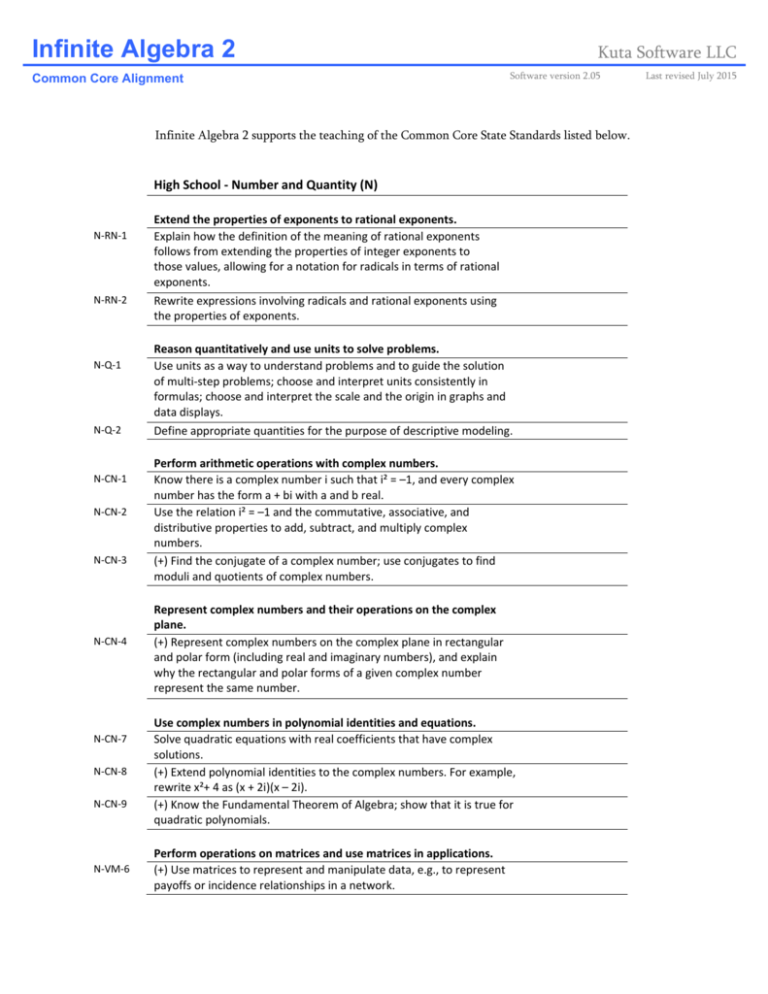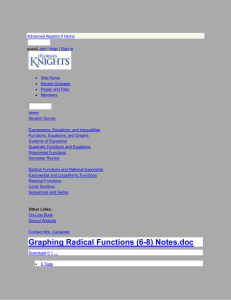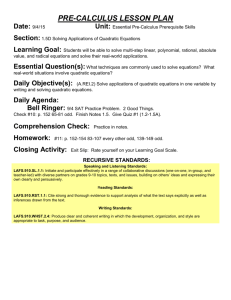
Infinite Algebra 2
Common Core Alignment
Kuta Software LLC
Software version 2.05
Infinite Algebra 2 supports the teaching of the Common Core State Standards listed below.
High School ‐ Number and Quantity (N) N‐RN‐1 Extend the properties of exponents to rational exponents.
Explain how the definition of the meaning of rational exponents
follows from extending the properties of integer exponents to those values, allowing for a notation for radicals in terms of rational exponents. Rewrite expressions involving radicals and rational exponents using
the properties of exponents. Reason quantitatively and use units to solve problems.
Use units as a way to understand problems and to guide the solution
of multi‐step problems; choose and interpret units consistently in formulas; choose and interpret the scale and the origin in graphs and data displays. Define appropriate quantities for the purpose of descriptive modeling.
Perform arithmetic operations with complex numbers.
Know there is a complex number i such that i² = –1, and every complex
number has the form a + bi with a and b real. Use the relation i² = –1 and the commutative, associative, and
distributive properties to add, subtract, and multiply complex numbers. (+) Find the conjugate of a complex number; use conjugates to find
moduli and quotients of complex numbers. Represent complex numbers and their operations on the complex
plane. (+) Represent complex numbers on the complex plane in rectangular
and polar form (including real and imaginary numbers), and explain why the rectangular and polar forms of a given complex number represent the same number. Use complex numbers in polynomial identities and equations.
Solve quadratic equations with real coefficients that have complex
solutions. (+) Extend polynomial identities to the complex numbers. For example, rewrite x²+ 4 as (x + 2i)(x – 2i). (+) Know the Fundamental Theorem of Algebra; show that it is true for
quadratic polynomials. Perform operations on matrices and use matrices in applications.
(+) Use matrices to represent and manipulate data, e.g., to represent
payoffs or incidence relationships in a network. N‐RN‐2 N‐Q‐1 N‐Q‐2 N‐CN‐1 N‐CN‐2 N‐CN‐3 N‐CN‐4 N‐CN‐7 N‐CN‐8 N‐CN‐9 N‐VM‐6 Last revised July 2015
N‐VM‐7 N‐VM‐8 N‐VM‐9 N‐VM‐10 N‐VM‐11 A‐SSE‐1a A‐SSE‐1b A‐SSE‐2 A‐SSE‐3a A‐SSE‐3b A‐SSE‐3c A‐SSE‐4 A‐APR‐1 (+) Multiply matrices by scalars to produce new matrices, e.g., as when
all of the payoffs in a game are doubled. (+) Add, subtract, and multiply matrices of appropriate dimensions.
(+) Understand that, unlike multiplication of numbers, matrix
multiplication for square matrices is not a commutative operation, but still satisfies the associative and distributive properties. (+) Understand that the zero and identity matrices play a role in matrix
addition and multiplication similar to the role of 0 and 1 in the real numbers. The determinant of a square matrix is nonzero if and only if the matrix has a multiplicative inverse. (+) Multiply a vector (regarded as a matrix with one column) by a
matrix of suitable dimensions to produce another vector. Work with matrices as transformations of vectors. High School ‐ Algebra (A) Interpret the structure of expressions
Interpret parts of an expression, such as terms, factors, and
coefficients. Interpret complicated expressions by viewing one or more of their
parts as a single entity. For example, interpret P(1+r)ⁿ as the product of P and a factor not depending on P. Use the structure of an expression to identify ways to rewrite it. For example, see x⁴ – y⁴ as (x²)²– (y²)², thus recognizing it as a difference of squares that can be factored as (x² – y²)(x² + y²). Write expressions in equivalent forms to solve problems
Factor a quadratic expression to reveal the zeros of the function it
defines. Complete the square in a quadratic expression to reveal the
maximum or minimum value of the function it defines. Use the properties of exponents to transform expressions for
exponential functions. For example the expression 1.15^t can be rewritten as (1.151/12)^(12t) ≈ 1.01212^t to reveal the approximate equivalent monthly interest rate if the annual rate is 15%. Derive the formula for the sum of a finite geometric series (when the
common ratio is not 1), and use the formula to solve problems. For example, calculate mortgage payments. Perform arithmetic operations on polynomials
Understand that polynomials form a system analogous to the integers,
namely, they are closed under the operations of addition, subtraction, and multiplication; add, subtract, and multiply polynomials. A‐APR‐2 A‐APR‐3 A‐APR‐5 A‐APR‐6 A‐APR‐7 A‐CED‐1 A‐CED‐2 A‐CED‐3 A‐REI‐1 A‐REI‐2 A‐REI‐3 Understand the relationship between zeros and factors of polynomials
Know and apply the Remainder Theorem: For a polynomial p(x) and a
number a, the remainder on division by x – a is p(a), so p(a) = 0 if and only if (x – a) is a factor of p(x). Identify zeros of polynomials when suitable factorizations are
available, and use the zeros to construct a rough graph of the function defined by the polynomial. Use polynomial identities to solve problems
(+) Know and apply the Binomial Theorem for the expansion of (x + y)ⁿ
in powers of x and y for a positive integer n, where x and y are any numbers, with coefficients determined for example by Pascal’s Triangle. Rewrite rational expressions Rewrite simple rational expressions in different forms; write a(x)/b(x)
in the form q(x) + r(x)/b(x), where a(x), b(x), q(x), and r(x) are polynomials with the degree of r(x) less than the degree of b(x), using inspection, long division, or, for the more complicated examples, a computer algebra system. (+) Understand that rational expressions form a system analogous
to the rational numbers, closed under addition, subtraction, multiplication, and division by a nonzero rational expression; add, subtract, multiply, and divide rational expressions. Create equations that describe numbers or relationships
Create equations and inequalities in one variable and use them to
solve problems. Include equations arising from linear and quadratic functions, and simple rational and exponential functions. Create equations in two or more variables to represent relationships
between quantities; graph equations on coordinate axes with labels and scales. Represent constraints by equations or inequalities, and by systems of
equations and/or inequalities, and interpret solutions as viable or non‐ viable options in a modeling context. For example, represent inequalities describing nutritional and cost constraints on combinations of different foods. Understand solving equations as a process of reasoning and explain
the reasoning Explain each step in solving a simple equation as following from the
equality of numbers asserted at the previous step, starting from the assumption that the original equation has a solution. Construct a viable argument to justify a solution method. Solve simple rational and radical equations in one variable, and give
examples showing how extraneous solutions may arise. Solve equations and inequalities in one variable
Solve linear equations and inequalities in one variable, including
equations with coefficients represented by letters. A‐REI‐4a A‐REI‐4b A‐REI‐5 A‐REI‐6 A‐REI‐7 A‐REI‐8 A‐REI‐9 A‐REI‐10 A‐REI‐11 A‐REI‐12 Use the method of completing the square to transform any
quadratic equation in x into an equation of the form (x – p)² = q that has the same solutions. Derive the quadratic formula from this form. Solve quadratic equations by inspection (e.g., for x² = 49), taking
square roots, completing the square, the quadratic formula and factoring, as appropriate to the initial form of the equation. Recognize when the quadratic formula gives complex solutions and write them as a ± bi for real numbers a and b. Solve systems of equations Prove that, given a system of two equations in two variables, replacing
one equation by the sum of that equation and a multiple of the other produces a system with the same solutions. Solve systems of linear equations exactly and approximately (e.g., with
graphs), focusing on pairs of linear equations in two variables. Solve a simple system consisting of a linear equation and a quadratic
equation in two variables algebraically and graphically. For example, find the points of intersection between the line y = –3x and the circle x² + y² = 3. (+) Represent a system of linear equations as a single matrix equation
in a vector variable. (+) Find the inverse of a matrix if it exists and use it to solve systems
of linear equations (using technology for matrices of dimension 3 × 3 or greater). Represent and solve equations and inequalities graphically
Understand that the graph of an equation in two variables is the set of
all its solutions plotted in the coordinate plane, often forming a curve (which could be a line). Explain why the x‐coordinates of the points where the graphs of
the equations y = f(x) and y = g(x) intersect are the solutions of the equation f(x) = g(x); find the solutions approximately, e.g., using technology to graph the functions, make tables of values, or find successive approximations. Include cases where f(x) and/or g(x) are linear, polynomial, rational, absolute value, exponential, and logarithmic functions. Graph the solutions to a linear inequality in two variables as a half‐
plane (excluding the boundary in the case of a strict inequality), and graph the solution set to a system of linear inequalities in two variables as the intersection of the corresponding half‐planes. High School ‐ Functions (F) F‐IF‐1 Understand the concept of a function and use function notation
Understand that a function from one set (called the domain) to
another set (called the range) assigns to each element of the domain exactly one element of the range. If f is a function and x is an element of its domain, then f(x) denotes the output of f corresponding to the input x. The graph of f is the graph of the equation y = f(x). F‐IF‐2 Use function notation, evaluate functions for inputs in their domains,
and interpret statements that use function notation in terms of a context. Recognize that sequences are functions, sometimes defined
recursively, whose domain is a subset of the integers. For example, the Fibonacci sequence is defined recursively by f(0) = f(1) = 1, f(n+1) = f(n) + f(n‐1) for n ≥ 1. Interpret functions that arise in applications in terms of the context
For a function that models a relationship between two quantities,
interpret key features of graphs and tables in terms of the quantities, and sketch graphs showing key features given a verbal description of the relationship. Key features include: intercepts; intervals where the function is increasing, decreasing, positive, or negative; relative maximums and minimums; symmetries; end behavior; and periodicity. F‐IF‐3 F‐IF‐4 F‐IF‐7a F‐IF‐7b F‐IF‐7c F‐IF‐7d F‐IF‐7e F‐IF‐8a F‐IF‐8b F‐IF‐9 Analyze functions using different representations
Graph linear and quadratic functions and show intercepts,
maxima, and minima. Graph square root, cube root, and piecewise‐defined functions,
including step functions and absolute value functions. Graph polynomial functions, identifying zeros when suitable
factorizations are available, and showing end behavior. (+) Graph rational functions, identifying zeros and asymptotes
when suitable factorizations are available, and showing end behavior. Graph exponential and logarithmic functions, showing intercepts
and end behavior, and trigonometric functions, showing period, midline, and amplitude. Use the process of factoring and completing the square in a
quadratic function to show zeros, extreme values, and symmetry of the graph, and interpret these in terms of a context. Use the properties of exponents to interpret expressions for
exponential functions. For example, identify percent rate of change in functions such as y = (1.02)^t, y = (0.97)^t, y = (1.01)^(12t), y = (1.2)^(t/10), and classify them as representing exponential growth or decay Compare properties of two functions each represented in a different
way (algebraically, graphically, numerically in tables, or by verbal descriptions). For example, given a graph of one quadratic function and an algebraic expression for another, say which has the larger maximum. F‐BF‐1a F‐BF‐1c F‐BF‐2 F‐BF‐3 F‐BF‐4a F‐BF‐4b F‐BF‐5 F‐LE‐2 F‐TF‐1 F‐TF‐2 F‐TF‐3 F‐TF‐4 Build a function that models a relationship between two quantities
Determine an explicit expression, a recursive process, or steps for
calculation from a context. (+) Compose functions. For example, if T(y) is the temperature in the atmosphere as a function of height, and h(t) is the height of a weather balloon as a function of time, then T(h(t)) is the temperature at the location of the weather balloon as a function of time. Write arithmetic and geometric sequences both recursively and
with an explicit formula, use them to model situations, and translate between the two forms. Build new functions from existing functions
Identify the effect on the graph of replacing f(x) by f(x) + k, k f(x),
f(kx), and f(x + k) for specific values of k (both positive and negative); find the value of k given the graphs. Experiment with cases and illustrate an explanation of the effects on the graph using technology. Include recognizing even and odd functions from their graphs and algebraic expressions for them. Solve an equation of the form f(x) = c for a simple function f
that has an inverse and write an expression for the inverse. For example, f(x) =2x³ or f(x) = (x+1)/(x–1) for x ≠ 1. (+) Verify by composition that one function is the inverse of
another. (+) Understand the inverse relationship between exponents and
logarithms and use this relationship to solve problems involving logarithms and exponents. Construct and compare linear, quadratic, and exponential models
and solve problems Construct linear and exponential functions, including arithmetic and
geometric sequences, given a graph, a description of a relationship, or two input‐output pairs (include reading these from a table). Extend the domain of trigonometric functions using the unit circle
Understand radian measure of an angle as the length of the arc on the
unit circle subtended by the angle. Explain how the unit circle in the coordinate plane enables the
extension of trigonometric functions to all real numbers, interpreted as radian measures of angles traversed counterclockwise around the unit circle. (+) Use special triangles to determine geometrically the values of sine,
cosine, tangent for π/3, π/4 and π/6, and use the unit circle to express the values of sine, cosine, and tangent for π–x, π+x, and 2π–x in terms of their values for x, where x is any real number. (+) Use the unit circle to explain symmetry (odd and even) and
periodicity of trigonometric functions. F‐TF‐6 F‐TF‐9 Model periodic phenomena with trigonometric functions
(+) Understand that restricting a trigonometric function to a domain
on which it is always increasing or always decreasing allows its inverse to be constructed. Prove and apply trigonometric identities
(+) Prove the addition and subtraction formulas for sine, cosine, and
tangent and use them to solve problems. High School ‐ Geometry (G) G‐CO‐2 Experiment with transformations in the plane
Represent transformations in the plane using, e.g., transparencies
and geometry software; describe transformations as functions that take points in the plane as inputs and give other points as outputs. Compare transformations that preserve distance and angle to those that do not (e.g., translation versus horizontal stretch). G‐CO‐3 Given a rectangle, parallelogram, trapezoid, or regular polygon,
describe the rotations and reflections that carry it onto itself. Given a geometric figure and a rotation, reflection, or translation,
draw the transformed figure using, e.g., graph paper, tracing paper, or geometry software. Specify a sequence of transformations that will carry a given figure onto another. Understand congruence in terms of rigid motions
Use geometric descriptions of rigid motions to transform figures and
to predict the effect of a given rigid motion on a given figure; given two figures, use the definition of congruence in terms of rigid motions to decide if they are congruent. Define trigonometric ratios and solve problems involving right triangles
Understand that by similarity, side ratios in right triangles are
properties of the angles in the triangle, leading to definitions of trigonometric ratios for acute angles. Explain and use the relationship between the sine and cosine of
complementary angles. Use trigonometric ratios and the Pythagorean Theorem to solve right
triangles in applied problems. Apply trigonometry to general triangles
(+) Prove the Laws of Sines and Cosines and use them to solve
problems. (+) Understand and apply the Law of Sines and the Law of Cosines
to find unknown measurements in right and non‐right triangles (e.g., surveying problems, resultant forces). G‐CO‐5 G‐CO‐6 G‐SRT‐6 G‐SRT‐7 G‐SRT‐8 G‐SRT‐10 G‐SRT‐11 G‐C‐5 G‐GPE‐1 G‐GPE‐2 G‐GPE‐3 G‐GPE‐5 S‐CP‐1 S‐CP‐2 S‐CP‐3 S‐CP‐5 S‐CP‐6 Find arc lengths and areas of sectors of circles
Derive using similarity the fact that the length of the arc intercepted
by an angle is proportional to the radius, and define the radian measure of the angle as the constant of proportionality; derive the formula for the area of a sector. Translate between the geometric description and the equation for a
conic section Derive the equation of a circle of given center and radius using the
Pythagorean Theorem; complete the square to find the center and radius of a circle given by an equation. Derive the equation of a parabola given a focus and directrix.
(+) Derive the equations of ellipses and hyperbolas given the foci,
using the fact that the sum or difference of distances from the foci is constant. Use coordinates to prove simple geometric theorems algebraically
Prove the slope criteria for parallel and perpendicular lines and use
them to solve geometric problems (e.g., find the equation of a line parallel or perpendicular to a given line that passes through a given point). High School ‐ Statistics & Probability (S) Understand independence and conditional probability and use them
to interpret data Describe events as subsets of a sample space (the set of outcomes)
using characteristics (or categories) of the outcomes, or as unions, intersections, or complements of other events (“or,” “and,” “not”). Understand that two events A and B are independent if the probability
of A and B occurring together is the product of their probabilities, and use this characterization to determine if they are independent. Understand the conditional probability of A given B as P(A and
B)/P(B), and interpret independence of A and B as saying that the conditional probability of A given B is the same as the probability of A, and the conditional probability of B given A is the same as the probability of B. Recognize and explain the concepts of conditional probability and
independence in everyday language and everyday situations. For example, compare the chance of having lung cancer if you are a smoker with the chance of being a smoker if you have lung cancer. Use the rules of probability to compute probabilities of compound
events in a uniform probability model Find the conditional probability of A given B as the fraction of B’s
outcomes that also belong to A, and interpret the answer in terms of the model. S‐CP‐7 S‐CP‐8 S‐CP‐9 Apply the Addition Rule, P(A or B) = P(A) + P(B) – P(A and B), and
interpret the answer in terms of the model. (+) Apply the general Multiplication Rule in a uniform probability
model, P(A and B) = P(A)P(B|A) = P(B)P(A|B), and interpret the answer in terms of the model. (+) Use permutations and combinations to compute probabilities of
compound events and solve problems. Standards from www.corestandards.org/assets/CCSSI_Math%20Standards.pdf
Standards are © Copyright 2010. National Governors Association Center for Best Practices and
Council of Chief State School Officers. All rights reserved.







